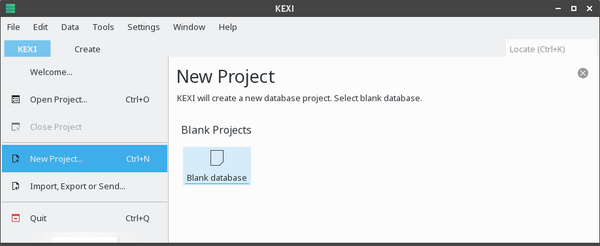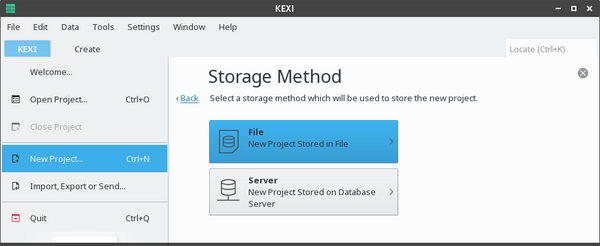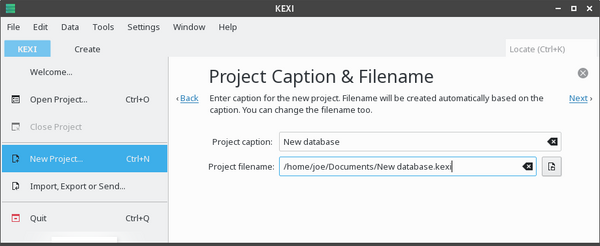|
|
| Line 1: |
Line 1: |
| <languages/> | | <languages/> |
| <translate> | | <translate> |
| ==Introduction== <!--T:1--> | | ===Setting Up a New Project=== <!--T:1--> |
|
| |
|
| <!--T:2--> | | <!--T:2--> |
| '''KEXI''' is a database management application. It can be used for creating databases, inserting data, performing queries, and processing data. Forms can be created to provide a custom interface to your data. All database objects - tables, queries and forms - are stored in the database, making it easy to share data and design. | | # Start the '''KEXI''' app, and use <menuchoice>KEXI->New Project... (Ctrl+N)</menuchoice>.</translate><translate><!--T:6--> |
| | | [[Image:NewProject.png|600px|center]] |
| <!--T:4--> | | # On the '''New Project''' page, under '''Blank Projects''' section, choose <menuchoice>Blank database</menuchoice>.</translate><translate><!--T:7--> |
| In addition to storing your '''KEXI''' databases in files, '''KEXI''' can also store your data on a database server. Using a database server allows you to share your database with other people, and also allows more than one person to use the database at one time. The following database servers are supported by '''KEXI''':
| | [[Image:ProjectStorage.png|600px|center]] |
| | | </translate> |
| <!--T:5--> | | <translate> |
| * [http://www.mysql.com/ MySQL] and [https://mariadb.org MariaDB]
| |
| | |
| <!--T:6--> | |
| * [http://www.postgresql.org/ PostgreSQL]
| |
| | |
| ===Brief History=== <!--T:12-->
| |
| | |
| <!--T:13--> | |
| KEXI development began in 2002 with the goal of bringing Microsoft Access-like functionality to the Free Software and Open Source community. The initiative aimed to provide a powerful yet user-friendly database management application tailored to the needs of open ecosystems. OpenOffice Polska (later renamed to OpenOffice Software) played a significant role in the early years, contributing extensively from 2003 to 2008.
| |
| | |
| <!--T:14--> | |
| Initially, KEXI was part of the broader KOffice project, which aimed to create a comprehensive Open Source office suite. Following the 2.3 release in 2010, KEXI became part of the [https://calligra.org/ Calligra Suite], the successor to KOffice. With version 3.1, KEXI reinstated official support for Microsoft Windows. Since version 3.2, KEXI releases have been independent of Calligra.
| |
| | |
| ===Getting More info=== <!--T:15-->
| |
| | |
| <!--T:7--> | |
| More information about '''KEXI''' can be found on the [http://www.kexi-project.org KEXI website]. There is also a dedicated [http://www.calligra-suite.org/kexi/ dedicated] on the Calligra website.
| |
| | |
| <!--T:8--> | | <!--T:8--> |
| If you have bugs to report, suggestions, or ideas to share, join the [https://discuss.kde.org KDE Discuss forums]. You can ask questions, share your work or ideas, or see what others are talking about. You will need a free account to post. Don't forget to use the 'kexi' tag in your posts.
| | # On the '''Storage Method''' page, click <menuchoice>File</menuchoice>.</translate><translate><!--T:9--> |
| | [[Image:ProjectFilename.png|600px|center]] |
| | </translate> |
| | <translate> |
| | <!--T:10--> |
| | #On the '''Project Caption & Filename''' page, you can type in a caption for your new project.</translate> |
| | <translate> |
| | <!--T:11--> |
| | # Click on <menuchoice>Next</menuchoice> to create the project. |
|
| |
|
| <!--T:16--> | | <!--T:3--> |
| It is easy to stay connected with the KEXI community through social media, chats, and mailing lists. Popular platforms are used for updates and announcements, real-time conversations in chat groups. Mailing lists can be subscribed for in-depth discussions and news. These channels are great for community interaction, and staying informed about the latest developments. Details are published at https://community.kde.org/Kexi/Contact.
| | {{Info| |
| | * When you change the project caption, '''KEXI''' will create the filename automatically based on the title you entered. |
| | * You can also enter a filename and use the file browser to choose a folder where you would like to save your project file.}} |
|
| |
|
| <!--T:9--> | | <!--T:4--> |
| {{Info|This handbook for '''KEXI''' 2.4 is meant to be based on the '''KEXI''' Handbook for Kexi 1.1. <br />Please coordinate any effort with Jarosław Staniek, email: kexi at kde.org}}
| |
| | |
| <!--T:10-->
| |
| {{Prevnext2 | | {{Prevnext2 |
| |nextpage=Special:MyLanguage/Kexi/Handbook/Kexi Basics | | |prevpage=Special:MyLanguage/Kexi/Handbook/Kexi_Basics/Kexi_Databases |
| |nexttext=Kexi Basics | | |prevtext=Kexi Databases |
| |index=Special:MyLanguage/Kexi/Handbook | | |nextpage=Special:MyLanguage/Kexi/Handbook/Kexi_Basics/The_Kexi_Main_Window |
| |indextext=Back to menu | | |nexttext=The Kexi Main Window |
| | |index=Special:MyLanguage/Kexi/Handbook|indextext=Back to menu |
| }} | | }} |
|
| |
|
| <!--T:11--> | | <!--T:5--> |
| [[Category:Kexi]] | | [[Category:Kexi]] |
| [[Category:Tutorials]] | | [[Category:Tutorials]] |
| </translate> | | </translate> |




